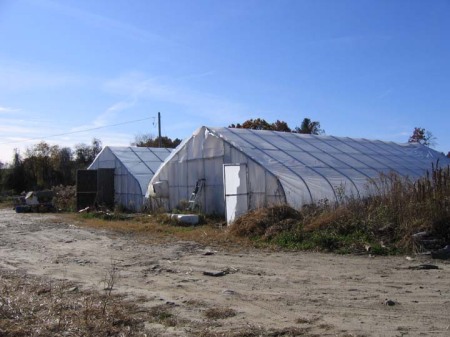How does a locavore host a party? I had the fun of answering that question last weekend. In the winter, I can’t simply go to the farmers market and buy more food. What we have is what we have. Party vegetables – the kind you can eat as finger food with dip – are in short supply in the winter. We have plenty of carrots, but I was feeling a bit selfish about my one celeriac and one (albeit Florida) pepper. Given the constraints, I got as close as I could.
I spent a lot of time wandering around my grocery store looking at labels. Apple cider was easy, and we served it both hot (mulled with spices) and cold. As usual, it was from Carlson Orchards in Harvard, MA (about 30 miles away). One of the ways I could identify other local foods was by the KVH kashrut symbol they bear. In many parts of the country, there are local organizations that certify local factories as kosher. If you’re in another part of the country, you might find a local kosher symbol in this list.
We served pita triangles with hommus to dip, both made by Joseph’s Middle East Bakery, based in Lawrence, MA (25 miles away). We served a selection of cheddar cheeses from Cabot, VT (190 miles) with organic crackers from Whole Foods. We shredded some of the cheddar and baked it between corn tortillas from Cinco de Mayo bakery in Chelsea, MA (5 miles) to make large batches of quesadillas, which we cut into quarters and served fresh from the oven with organic salsa from Whole Foods. Our guests really liked those! We also put out a few varieties of River Queen nuts processed in Everett, MA (5 miles).
I also bought, but never put out, chocolate candies from NECCO (New England Confectionary Company) now in Revere, MA (10 miles), and Madeleine cookies from Superior Cake Product in Southbridge, MA (60 miles). That was because we were too busy eating Hood ice cream from Lynnfield, MA (15 miles) with cake baked and brought by a friend. Another friend brought a delicious strawberry cordial, homemade with strawberries she picked last summer.
Because the party spanned supper time, we offered guests a choice of two soups, both pureed and incidentally both vegan: a bright squash-pumpkin-apple soup seasoned with curry and other spices and a creamy white cannelini-potato-turnip soup loaded with thyme. Recipes are below. Using our bread machine, we made a choice of breads, too: a whole wheat (well, half whole wheat, half white bread flour) and a garlic and herb white bread. As always, the whole wheat flour was Whole Foods organic, and the white bread flour was King Arthur, from Norwich, VT (130 miles away). To make the garlic bread, I added lots of chopped garlic, some garlic powder, and dried herbs like rosemary, oregano, and parsley to the bread machine after the water and before the flour. I also doubled the amount of oil to 4 tablespoons (1/4 cup) up from the usual 2 tablespoons.
The squash soup used the good parts of three butternut squash and one pumpkin that were all showing rotten spots. Because squash is so dense, it’s very easy to cut away the bad part and be left with good. I think the three squashes had good parts equivalent to two whole squashes. The pumpkin was nearly all good. I seeded, peeled, and chunked them, and tossed them into a stock pot. Six apples, cored and chunked, also went into the pot. An onion would have been good in there, but I never trust myself to cook them well enough for me to be able to eat them. I put in enough water to nearly fill the pot, but in retrospect I should have just covered the vegetables to end up with a thicker soup. I spiced the soup with curry, cinnamon, turmeric, cardamom, coriander, and ginger, and of course salt. Maybe something else I’m forgetting, too. I pureed the whole thing before serving.
I was particularly pleased with how the cannelini-potato-turnip soup came out. I started with dried cannelini. After soaking 1 1/2 cups of them overnight, they had swelled to about 4 cups. Those went into a saucepan with half a bulb of garlic (4 cloves, each cut up) more than enough water to cover. After the beans had simmered for more than half an hour before I added 5 small turnips (5 ounces) and 8 small potatoes (16 ounces), all chunked. In the process, I discovered that worms and rot had destroyed another 5 turnips, which had to go straight out to compost. Between soup and compost, the last of the turnips we harvested ourselves this fall (at our summer CSA farm) are gone. But back to the soup, because wormy, rotten vegetables are gross. The soup was an excuse to use up the rest of the thyme we had gotten from our winter CSA. It worked. The only other seasoning I added was salt (one rounded tablespoon) and pepper (about 10 grinds). When I pureed the soup, it seemed too thin. Then it sat in the refrigerator overnight. Even after it was reheated, it wasn’t too thin. It was thick, creamy, delicious, filling, vegan, and used up both turnips and thyme. I’ve found a winner!
Belatedly, I know, here are photos we took on the farm on the day in November when we picked those turnips, and brought home those squash as well.

